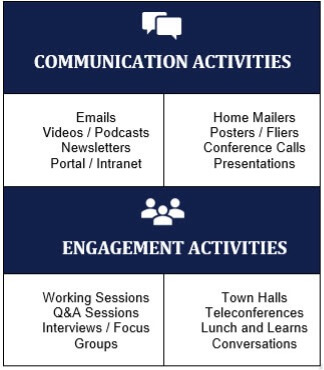No matter your reason for making a pay frequency change, there are several considerations and actions to take once the decision has been made – including the development and execution of a communications plan.
Is your organization making a change in pay frequency?
Whether you’re trying to simplify the payroll process, shift to a best practice or adjust to changing workforce preferences, there are a variety of reasons why an organization might consider making a pay frequency change. Whatever your reason, an important next step is to outline a communication strategy for sharing the news to your organization.
Money is a sensitive topic, and payday is highly anticipated for all. So, if you are making a significant change to how or when someone is paid — such as moving the schedule from weekly to bi-weekly — it’s critical to over-communicate the what, why, how, and when so employees can prepare in advance and smoothly transition to your new pay schedule.
Here are three important communications strategies you should employ when you introduce a pay frequency change.
1. Be clear about what’s changing, why, and when
The last thing you want to do is create ambiguity around your employees’ paycheques. The best communications strategies are built on messaging that’s clear and easy to understand and shared in a variety of ways, including preparing managers to help educate their employees, sending direct mail, running an email campaign, distributing messages through social collaboration tools and / or even creating printed handouts, posters, or table tents.
You need to develop a plan and address the following questions:
- What’s changing, why, and what do employees need to know / do?
- Are there any compliance or union requirements for advance notice or the timeline for communications?
- How will we address employee questions and concerns?
- And, what do we need to develop to help ensure our employees are aware, supported, and have the tools they need for this change?
Mapping this out in advance will allow you to develop a robust set of resources to help your workforce get ready for the change.
Be sure to use as little jargon as possible and avoid terms your audience might not be familiar with. For example, phrases like “bi-weekly in arrears” might be clear to you but may not resonate with front-line employees.
Furthermore, you’ll want to outline the timing around the changes so that employees can be prepared in advance. It will be important for employees to do things like: check their budget, bill pay, and savings strategies and make any adjustments to the timing of payments such as rent, mortgage, car payments, insurance, child support, tuition, and utilities. They may also need to adjust their automatic online bill payment(s). And, you may want to offer resources from your Employee Assistance Program (EAP) if your partner offers budgeting, financial planning and other resources. For compliance and union considerations, you will want to partner with your legal and HR teams to evaluate requirements and put a plan in place to meet applicable rules and regulations.
2. Identify key stakeholders and consider who needs to know what, when, and why
Another key part of an effective pay frequency change is helping to control how the news travels. If this information leaks before you can formally deliver the news yourself, it might upset or cause confusion among employees.
Before you communicate information about the change, identify different groups of stakeholders and determine when they should be informed. For example, although your executives will be involved in the decision-making process, you should outline the details of your communications approach before sharing that information with managers. Also, it’s important that managers understand what’s changing before front-line employees receive the news. This is not to restrict information, but rather help ensure each level is prepared, can provide support and answer questions accurately when the news becomes public knowledge.*
*Important note: Share and review your communications plan, including timing of the rollout, with your legal and HR teams prior to launch – as employee notification requirements may vary. Further, if you have a union population, there may be a need to review collective bargaining agreements and collaborate with union reps to help ensure everything is properly communicated.
You should also consider identifying a team of change champions that can serve as advocates for the change and help communicate the message to prepare employees. Change champions can help other employees understand the change, answer questions, and redirect more complex questions to your HR and / or payroll teams.
3. Support the rollout with tools and resources
People understand 10% of what they hear, 20% of what they read, and 80% of what they see and do. Use this knowledge to your advantage by supporting the rollout with tools and resources that will help your employees adjust to the change – including checklists, a payroll calendar, automated reminders, and employee assistance program (EAP) resources.
An effective way to deliver the message is to offer both communication and engagement activities. Below is an example of what this might look like for your workforce:

Communication strategies that smooth the say for pay frequency conversations
How often you pay your employees can be just as important as how much you pay them. That’s why it’s so important to make sure you approach conversations about pay changes with patience, compassion and clarity.
If you can be upfront about what’s changing, get the right information to the right people and support the rollout with easy-to-use tools, you can help to ensure a smooth transition for your employees and your organization.
Learn more
Launch this podcast anytime: Preventing Employee Burnout. Battling employee burnout extends far beyond yoga and meditation apps – it starts with the organization and your HR team. Stop this chronic cycle and dive in as special guest, HBR author and burnout expert Jennifer Moss, provides the actionable advice you can take to your leadership team today.
New capabilities are now available in ADP Workforce Now to help with bringing your people back to the workplace. These include a survey to understand employee sentiment and availability, scheduling, daily attestations, trend monitoring, and contact tracing. To see a video of the capabilities and learn more, visit www.adp.ca/returntoworkplace.
Learn how to prepare your data, your team, and your systems for the best possible transition. Download your HCM Integration Planning Guide here.
This article originally appeared on SPARK powered by ADP.



